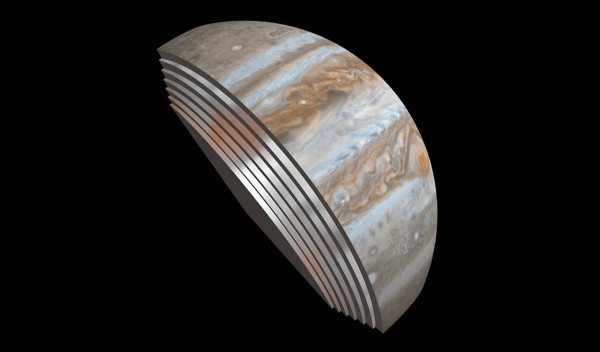By Ana Verayo, | October 24, 2016

This composite image depicts Jupiter’s cloud formations as seen through the eyes of Juno’s Microwave Radiometer (MWR) instrument as compared to the top layer, a Cassini Imaging Science Subsystem image of the planet.
New data from NASA's Jupiter probe Juno has revealed some surprises about the largest planet in the solar system, confirming that the gas giant's famous stripes go deep into its atmospheric layers.
Like Us on Facebook
In August, Juno arrived in the Jupiter system, conducting for the first time ever a very close flyby. The mission team is studying the highly radioactive environment of Jupiter, along with it's violent and intense weather patterns, said Juno principal investigator Scott Bolton.
These bizarre cloud patterns on Jupiter are bold and colorful. However, sunlight cannot penetrate whatever's underneath and on the surface of the gas giant. But Juno's onboard suite of scientific instruments can peer through these clouds via microwave spectrums and unravel these thick, mysterious layers.
Bolton describes these stripes as "zones and belts" that exists deep down the planet's surface, adding that the colors and stripe patterns are caused by whatever's deep down inside Jupiter, which is an astonishing finding since it was previously thought that these layers are only on the outside.
These new images taken by Juno were captured about 200 to 250 miles into the surface of Jupiter's cloud layer. Bolton says that these bands observed on the cloud tops are apparently unique from each other even if they appear similar.
Bolton noted that these layers are evolving and do not stay the same over time. This new finding could provide crucial clues about the dynamics and chemistry of the atmospheric layers of Jupiter.
This is the first time that Jupiter's atmosphere is being dissected and analyzed.
These new findings were discussed during the American Astronomical Society's Division for Planetary Sciences 2016 conference.
-
Use of Coronavirus Pandemic Drones Raises Privacy Concerns: Drones Spread Fear, Local Officials Say

-
Coronavirus Hampers The Delivery Of Lockheed Martin F-35 Stealth Fighters For 2020

-
Instagram Speeds Up Plans to Add Account Memorialization Feature Due to COVID-19 Deaths

-
NASA: Perseverance Plans to Bring 'Mars Rock' to Earth in 2031

-
600 Dead And 3,000 In The Hospital as Iranians Believed Drinking High-Concentrations of Alcohol Can Cure The Coronavirus

-
600 Dead And 3,000 In The Hospital as Iranians Believed Drinking High-Concentrations of Alcohol Can Cure The Coronavirus

-
COVID-19: Doctors, Nurses Use Virtual Reality to Learn New Skills in Treating Coronavirus Patients







